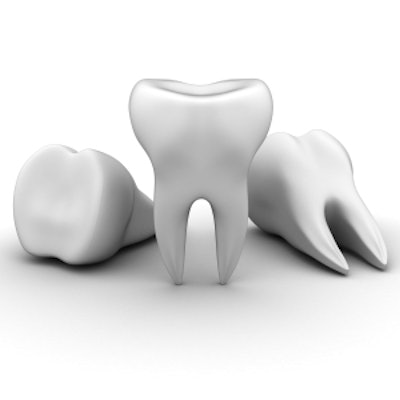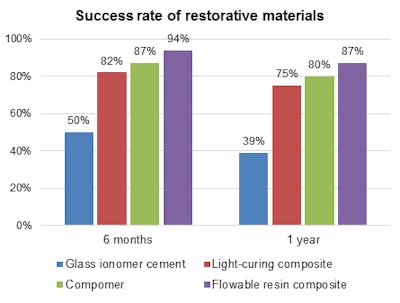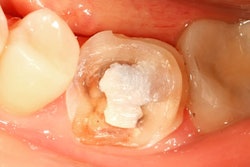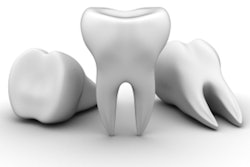
Restoring a wedge-shaped defect? You may not want to use glass ionomer cement (GIC). A new study found that the cement was not as clinically effective as similar restorative materials for these particular lesions.
Because wedge-shaped defects are noncarious lesions, they can be challenging to treat and to find the ideal material for. That's why a team of researchers from China evaluated four different restorative materials to find out which ones held up best over time. Their results were published in Medical Science Monitor (September 16, 2017).
"Restorative treatment has been demonstrated as an effective management strategy for WSD [wedge-shaped defects], but controversies still exist regarding the most suitable material," wrote the authors, led by Jian-Yong Ruan and Zheng-Lin Gong. "Our paper focused on comparing four widely used restorative materials ... while shedding a little light on the best material choice for dental WSD restoration."
Ruan is from the department of general dentistry at the Affiliated Stomatological Hospital of Fujian Medical University in Fuzhou, and Gong is from the department of stomatology at Ankang Central Hospital in Ankang.
Putting 4 materials to the test
Because wedge-shaped defects are often caused by erosion and abrasion, the restorative materials best suited to carious lesions may not be ideal for these lesions. Therefore, the researchers decided to test the clinical efficacy of four commonly used restorative materials to find out which ones worked best for these defects.
For their study, the researchers used glass ionomer cement (Qingbu Dental Materials), flowable resin composite (Filtek, 3M), compomer (Dyract, Dentsply Sirona), and light-curing composite resin (Beijing Gusha Biological Material). They chose those four materials because of their frequent clinical use and unique properties:
- Glass ionomer cement's composition helps it chemically adhere to enamel and dentin.
- Flowable resin composite has a low viscosity.
- Compomer is particularly wear-resistant.
- Light-curing composite resin tends to be stronger than polymer composites.
The study included 106 patients who needed wedge-shaped defects filled. In total, the researchers restored 280 maxillary premolars, each with one of the four materials.
They followed the patients for one year after the procedure to find out which materials were most successful. Success was defined as meeting all the following criteria: complete structure, closed margin, smooth surface, no gaps or staining, no caries, no sensitivity to heat or cold, normal pulp vitality, and no noticeable symptoms for the patient.

The researchers found flowable resin composite and compomer to be the best restorative materials for wedge-shaped defects. Both were significantly more successful at six and 12 months after restoration than glass ionomer cement, which was ranked last. Light-cured composite was significantly better than glass ionomer cement at six months but not 12 months.
"Our study provided evidence that GIC presented poorer restoration efficacy than the other three materials," the authors wrote.
In almost every metric tested, glass ionomer cements performed worse than the other three materials. Patients treated with the cements even ended up having worse periodontal markers. The researchers attributed this to the material's physical and chemical properties.
"GIC is a conventional dental restorative material with numerous advantages, such as its fluoride-releasing property and the ease of placement into gingival cavities," they wrote. "But at the same time, GIC does not only lack strength and toughness, it fails to maintain its stability in an acidic environment as it does in pure water."
It can't be ignored that the researchers chose to use a healthy population for this study and only tested one type of brand for each restorative material. Therefore, the results may not be indicative of a more heterogeneous population or of different restorative material brands. Nevertheless, glass ionomer cement appears not to be the ideal choice for restoring wedge-shaped defects.
"Flowable resin composites, Dyract compomers, and light-curing composite resin were favorable substitutes for GIC," they concluded. "However, further studies regarding the advantages and disadvantages of the three novel materials in WSD restoration are needed."



















